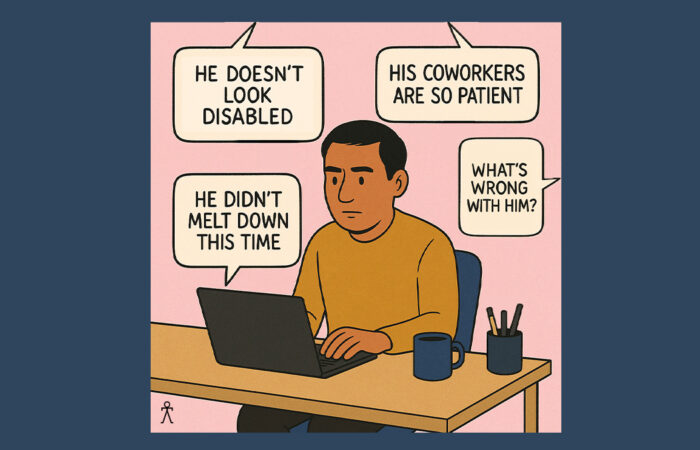By Menachem Rephun, Communications Manager at Creative Spirit
In January, President Donald Trump signed an executive order mandating the end of telework for all federal employees, requiring employees to be in-office 5 days a week. The move has raised questions about how the rule will apply to federal employees with disabilities, as remote work is a protected reasonable accommodation under the Rehabilitation Act of 1973.
In 2022, over 9% (more than 250,000) of federal employees identified as disabled, according to a report from USA Today. A 2023 survey from the Partnership for Public Service found that 21% of the federal workforce identified as having a disability, 2.7% identified as having a targeted or serious health condition, and 7.8% identified as having other disabilities or a serious health condition.
All of this raises the question of whether offices are ready to accommodate employees with disabilities who may be forced to return.
In a recent interview, federal employment attorney Aaron Szot noted that Trump’s executive order states that it will be consistent with applicable law, meaning that department and agency heads will be able to make exceptions they deem necessary. “We have a lot of federal employees who have already been granted telework as a reasonable accommodation,” Szot said in the interview with journalist Tom Temin. “And it will be difficult for an employer to revoke a telework, reasonable accommodation already in place.”
Szot also shared his thoughts on job changes that might result in telework not being considered an effective accommodation for employers. “What has changed?” Szot asked. “Do we have different essential functions that make telework no longer an accommodation that the employer can provide? Is there an undue hardship? Is there some new significant difficulty or expense that makes it prohibitive for an employer to provide telework?” In short, Szot believes agencies will have to review the situation of each employee on a case-by-case basis rather than having a blanket policy for everyone with a disability. He adds that his own firm offers guidance to employees with concerns about how changes in policy might impact their already existing accommodations. “So just making sure employers are acting consistent with their statutory obligations,” Szot adds, “and then again providing that support to employees as they work through this process with their employers.”
The Impact of Ending Telework for Employees With Disabilities
Some federal employees with disabilities have shared their anxiety about how the RTO mandate could impact their jobs. “It’s not the first time this has come up, it just feels louder this time,” Chelsea Milburn, a public affairs specialist for the Department of Education (which Trump has pledged to shut down), was quoted as saying by U.S.A. Today. Furthermore, only 15% of federal employees actually work in Washington, with 85% spread out across other big cities and capitals, such as the U.S.A. Today also points out.
Some disability advocates and experts have voiced their concerns about the short and long-term consequences of eliminating telework for employees with disabilities. Alycia Anderson, a disabled TEDx motivational speaker and Diversity, Equity, Inclusion, Accessibility, and Disability consultant, believes the RTO mandate “poses a serious challenge for people with disabilities who had experienced an uptick in employment opportunities during the era of remote work.” Anderson points out that employment rates for people with disabilities increased during the COVID-19 pandemic by removing accessibility barriers in transportation and the need for specific accommodations. “Without flexible scheduling or the ability to work from home,” Anderson writes, “people with disabilities may face increased difficulty in maintaining their employment or accessing job opportunities.” She points out that traditional office spaces are not always fully accessible, preventing employees with mobility challenges from working effectively. Health concerns are also an issue for people with chronic conditions or compromised immune systems, who might be asked to return to work environments where exposure to illness is a risk. Most importantly, Anderson stresses that returning to in-person work should not come at the expense of equal opportunity or accessibility and that the disability community “must come together to demand progress, ensure accountability, and uphold the rights fought for by generations before us.”
Could RTO Mandates Undo DEI Progress for Employees With Disabilities?
Along with the issues discussed above, some have pointed out a direct link between return-to-office (RTO) mandates and the fact that many companies are scaling back their Diversity, Equity, and Inclusion (DEI) efforts. In a report from February of last year, DisabilityTalent.org writes that RTO mandates will pose a setback to DEI progress for people with disabilities, as they “put undue pressure on disabled individuals who may struggle with commuting and/or transportation accessibility.” DisabilityTalent also notes that in-office work limits the talent pool geographically, as well as from a skillset and experience level, as the top candidate for a given role might live across the country and be unwilling or unable to relocate. Furthermore, offices tend to be unfavorable to employees with disabilities, many of whom are not at their most productive when surrounded by distractions, people, and noise. The employment rate for people with disabilities also substantially increased as a result of the work-from-home policy allowed during the COVID-19 pandemic.
In January 2020, 5.7 million Americans with disabilities were employed. By fall of 2023, the number had increased by 33% to to 7.3 million, and now sits at 7.9 million. Forcing a return-to-work could potentially jeopardize these improvements. At the same time, DisabilityTalent writes that there are numerous ways for employers to support professionals with disabilities in their physical office spaces. This includes communicating DEI/disability initiatives across the organization and holding leadership accountable for progress through transparent data sharing; providing education, training, and support to all employees on disability and ableism; and improving accessibility and inclusion in recruitment, onboarding, and career development. Employers can also implement Universal Design to make workplaces more physically accessible for employees with disabilities/neurodiversity.
Recent studies have also shown that many employees with disabilities are more likely to stay in their jobs if hybrid work options are available. DisabilityTalent cites a McKinsey report, which found that employees with disabilities are 14% more likely than non-disabled employees to leave their place of employment if remote work or hybrid work options are not available. The McKinsey survey also found that 56% of professionals know someone who has quit their job or plans to quit due to return-to-office mandates. 63% of the professionals surveyed said they were even willing to take a pay cut if it meant being allowed to work remotely. This strongly suggests that companies benefit from allowing employees, especially those with disabilities, to work remotely, or at the very least, to allow a hybrid option. “Employers should question why they are mandating their employees to work from the office,” McKinsey writes. “Justifying it with collaboration or management issues is not sufficient…Providing workers with autonomy can foster a positive work environment and ultimately improve productivity, job satisfaction, and company culture.”
Return to Office: Do the Benefits Outweigh the Costs?
While many disability rights advocates have shared their concerns about the new return-to-office mandate, some have weighed in with possible benefits and advantages of returning to in-person work. In a blog post from September of 2024, Rooney Law writes that physical workspaces can be beneficial in combating loneliness and fostering social connections, along with enhancing teamwork, productivity, and innovation. They also write that working from the office can reduce burnout by helping employees re-establish boundaries between work and personal life. That being said, the article acknowledges that a mandatory return-to-office could lead to dissatisfaction and push employees to look elsewhere. In its article evaluating the pros and cons of remote work, Payday HCM.com refers to a study from Nature Human Behavior, which found that remote workers at Microsoft became more isolated and less communicative with coworkers outside their team. A report from the social media management company Buffer found that many remote workers had trouble unplugging from work, with 81% checking their email after work hours.
Returning to the Office Is A Challenge and an Opportunity
The current return-to-office mandate seems fairly strict on the surface, though it does offer some leeway through a deferred resignation policy, which offers a financial incentive for voluntary resignations. Federal employees who agree to resign by Feb. 6, 2025 will receive up to 8 months of salary and will not be required to return to in-person work.
However, as National Security Law Firm points out, employees with disabilities “should not feel forced to resign if you require a reasonable accommodation to continue working.” They add that reasonable accommodations still include continued telework, a hybrid work schedule, alternative work locations, modified work schedules, physical workspace modifications, and/or extended leave.
Federal employees also still have recourse if their request for reasonable accommodation/accommodations is denied. These include filing a a discrimination complaint with your company’s Equal Employment Opportunity (EEO) office; appealing the denial; or filing a formal charge of discrimination with the Equal Employment Opportunity Commission (EEOC).
The new RTO mandate raises many legitimate concerns about employment for federal employees with disabilities. However, with challenge comes opportunity. In its article “18 Overlooked Benefits of Returning to the Office for Work”, the Forbes Human Resources Council writes that working from the office can be positive for mental health by providing an outlet for connection and social interaction. Working from the office can also improve mentorship and coaching for young neurodiverse employees by enabling face-to-face interaction. Additionally, in-person work can improve visibility by allowing neurodiverse employees to see when they need to be included and advocating for themselves, in contrast to working remotely, where employees can be shut out of meetings. An even more important silver lining of the RTO mandate may be in prompting employers not to take neurodiverse talent for granted, to think much more seriously about the importance of providing reasonable accommodations for neurodiverse employees, and to recognize why those accommodations are actually beneficial for everyone. Creative Spirit is here to help make that happen through our comprehensive, first-of-its-kind training program, which guides employers toward becoming fully inclusive and accommodating for neurodiverse employees. In a time of uncertainty, self-advocacy and knowing your rights as a neurodiverse professional is more crucial than ever. The State of New Jersey in particular offers legal protection through its Law Against Discrimination, which protects against workplace bias. You can learn more here: https://www.nj.gov/lps/dcr/downloads/NJ-Law-Against-Discrimination-Most-Updated.pdf, and be sure to visit us at https://www.creativespirit-us.org/ for more info on our services and mission.
Sources:
- https://federalnewsnetwork.com/workforce/2025/01/how-the-return-to-office-order-affects-people-with-disabilities/
- https://www.usatoday.com/story/money/2025/01/19/trump-plans-federal-workers-job-uncertainty/77048619007/
- https://alyciaanderson.com/how-does-the-return-to-in-person-work-order-affect-people-with-disabilities/?srsltid=AfmBOorMMhBp-IXF7oESq5DjT4DAWfOXX7tnk09e2qRUwGZRHbqpUbnj
- EEOC.Gov
- https://www.disabilitytalent.org/single-post/return-to-office-mandates-what-they-mean-for-disabled-workers






